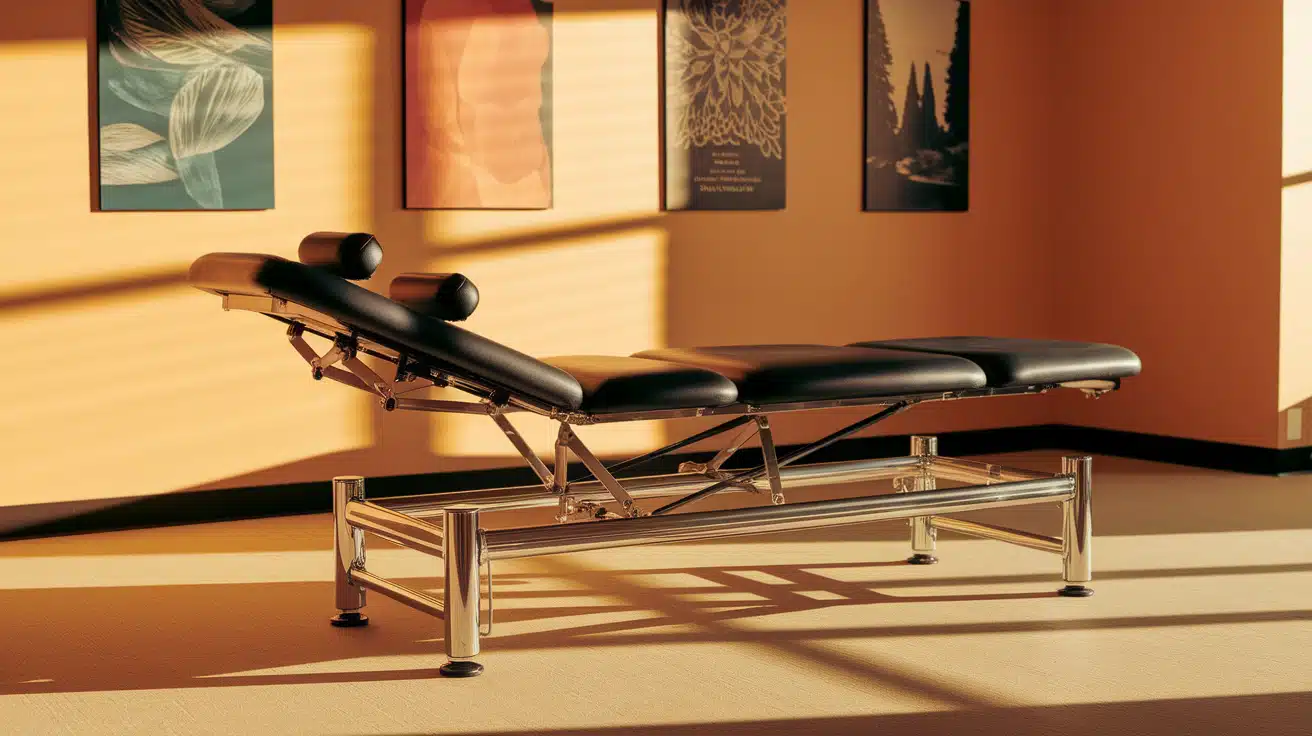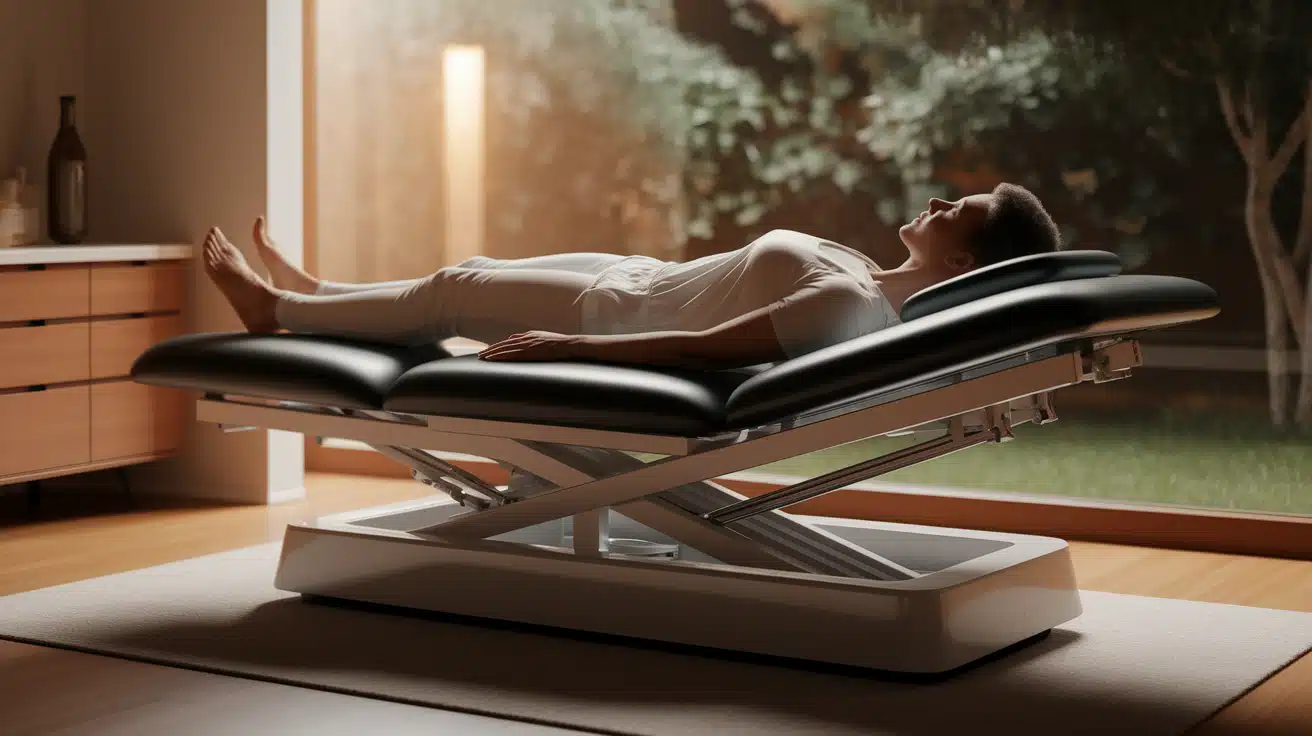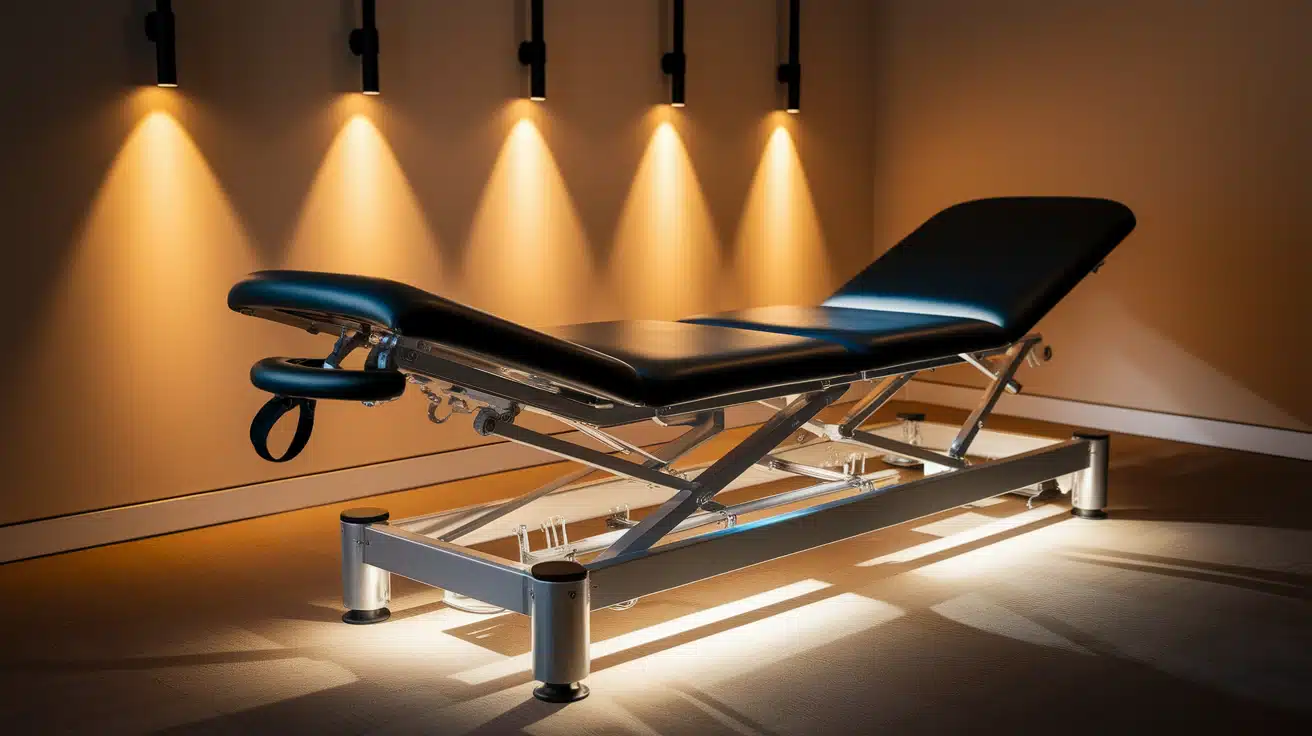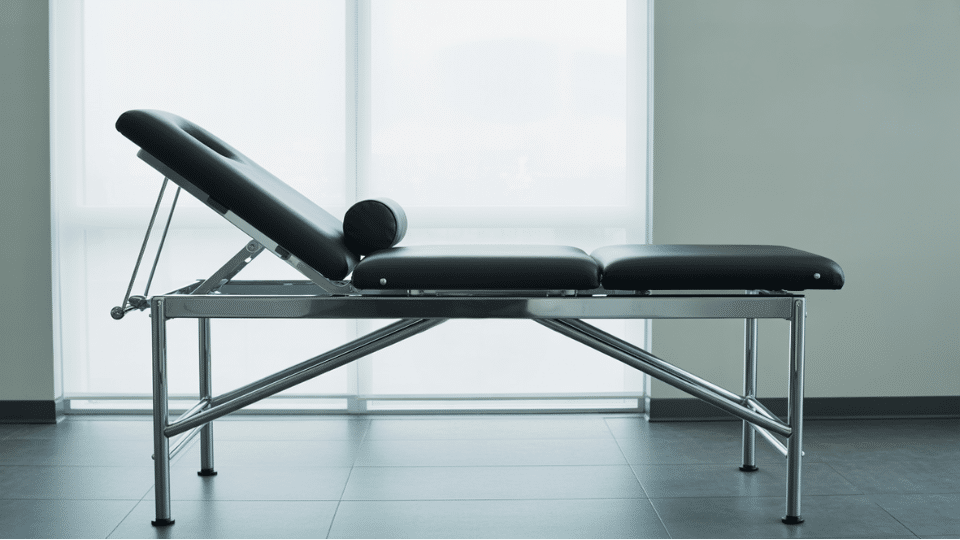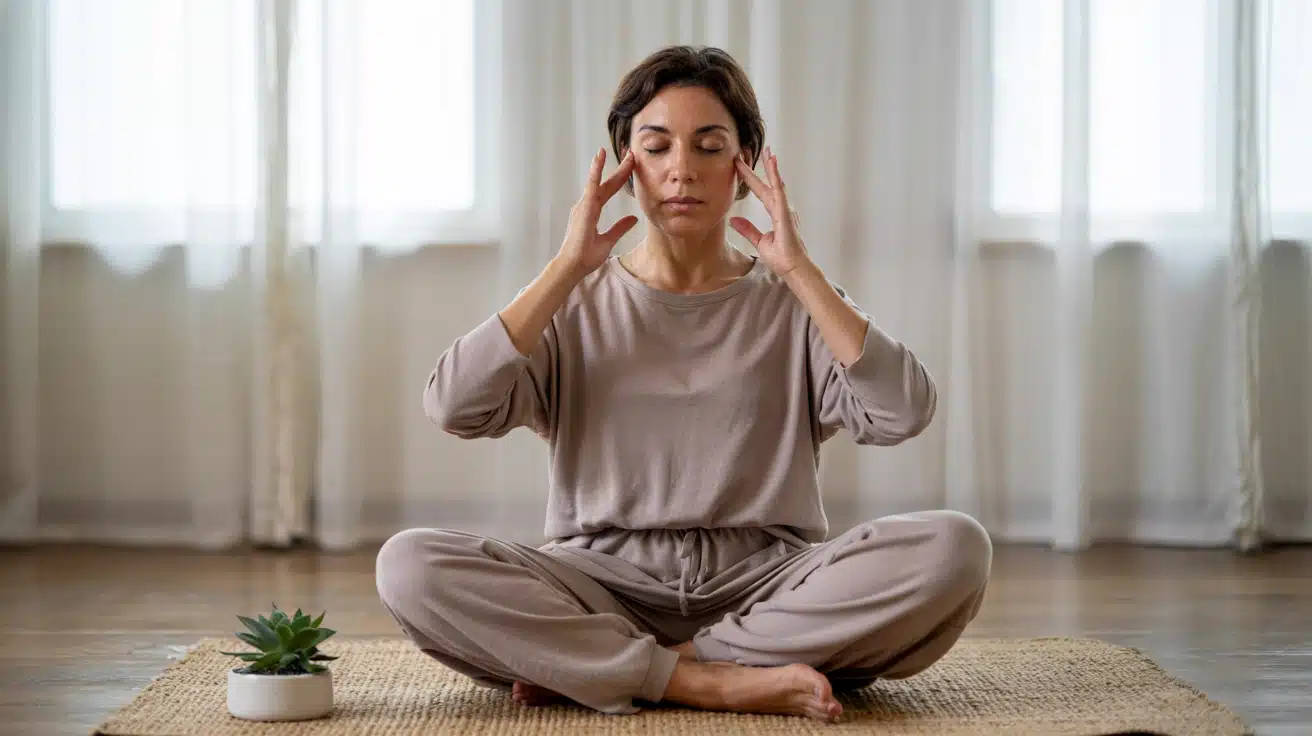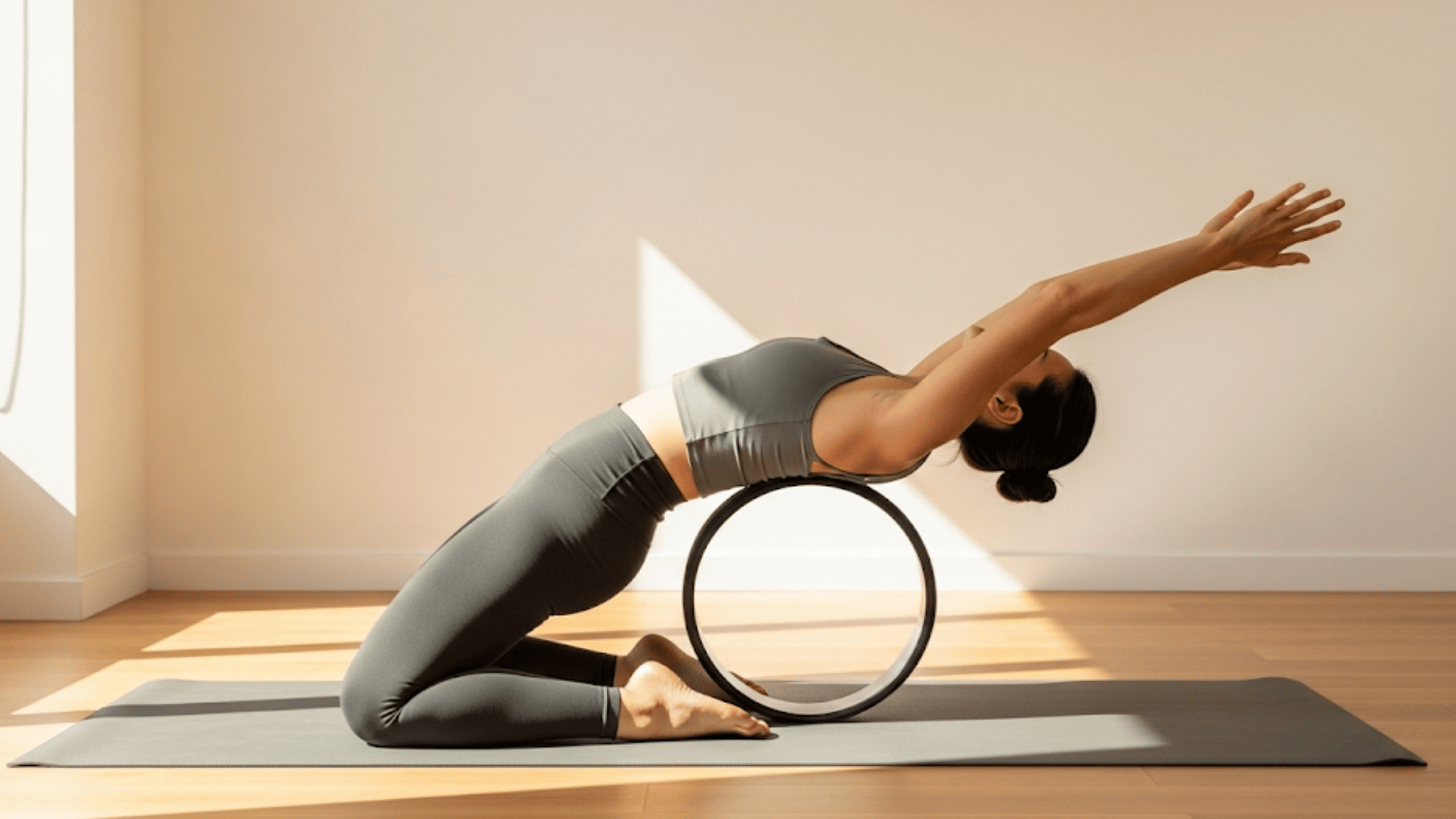Back pain affects millions of people worldwide, forcing them to rely on expensive treatments, risky surgeries, or daily medication to function normally.
Traditional pain management often provides temporary relief while the root cause of spinal compression remains untreated.
A traction table offers a proven, non-surgical solution that gently stretches your spine to relieve pressure, reduce nerve compression, and restore natural mobility from the comfort of your home.
This comprehensive guide will help you understand what traction tables are, determine if you’re a suitable candidate, compare the top models available in 2025, and make an informed purchase decision that suits your specific needs and budget.
What is a Traction Table?
A traction table is a medical device that applies controlled stretching force to your spine. This gentle pulling helps reduce pressure between spinal discs and relieves nerve compression that causes back pain.
Unlike inversion tables that flip you upside down or basic decompression machines, traction tables offer precise control over the stretching force and angle.
First developed in hospitals during the 1960s, modern traction tables now feature computerized controls, adjustable settings, and home-friendly designs, making spinal therapy more accessible than ever before.
Types of Traction Tables
| Type | Best For | Pros | Cons |
|---|---|---|---|
| Manual | Budget-conscious users, clinics with hands-on therapists | Low cost, no power needed | Less precise, effort-intensive |
| Motorized | Clinics, advanced home users | Precise, programmable, easy to use | Expensive, needs electricity |
| Cervical | Neck pain, pinched nerves | Targeted relief, portable | Limited to the upper spine |
| Lumbar | Lower back pain, herniated discs | Deep traction, full-body stretch | Bulky, needs proper setup |
| Clinical-Use | Professional settings | Durable, advanced features | High cost, large footprint |
| Home-Use | Individuals managing pain at home | Compact, affordable, user-friendly | Limited controls, less power |
Who Should Use or Avoid Traction Tables?
Ideal Users of Traction Table
Traction tables provide effective relief for people dealing with chronic spinal conditions, injury recovery, or lifestyle-related back problems.
These devices are most effective when used consistently as part of a comprehensive pain management or rehabilitation program.
Most users see significant improvement within 2-4 weeks of regular use, especially when combined with proper exercise and posture habits.
- Individuals with chronic back or neck pain
- Post-operative recovery patients
- Physical therapy patients
- Athletes and fitness enthusiasts
- Office workers with desk jobs
- Seniors with age-related spinal changes
Who Should Avoid Using a Traction Table?
- People with osteoporosis – Weakened bones can fracture under traction force, even at low settings. Bone density tests are essential before starting any spinal stretching program.
- Active fractures or recent injuries – Broken bones, torn ligaments, or acute injuries need time to heal before applying any stretching force. Wait for medical clearance first.
- Spinal tumors or cancer – Traction can spread cancer cells or worsen tumor-related pain. Oncology approval is required before commencing any spinal therapy.
- Severe spinal instability – Conditions like spondylolisthesis or severe arthritis may worsen with traction. Advanced imaging and specialist evaluation are necessary.
- Pregnancy – Hormonal changes already loosen ligaments, and additional stretching could cause joint instability or complications.
- Acute inflammation or infection – Active infections, severe disc herniation, or inflammatory conditions require medical treatment before traction therapy.
Always consult your doctor before starting traction therapy, especially if you have existing medical conditions or take medications that affect bone density.
Key Benefits of Using a Traction Table
A traction table provides targeted spinal decompression, enhanced circulation, and pain relief, enabling rehabilitation and improved mobility without the need for invasive procedures.
- Targeted Pain Relief – Gentle stretching separates compressed vertebrae and reduces nerve irritation that causes shooting pain.
- Surgery-Free Spine Treatment – Avoid risky surgery by using controlled traction to create space between your spinal discs naturally.
- Posture Correction and Spinal Alignment – Regular traction sessions help retrain your spine to maintain its natural curves and reduce slouching habits.
- Faster Recovery and Rehabilitation – Combining traction with physical therapy exercises accelerates recovery and strengthens the supporting muscles.
- Enhanced Mobility and Circulation – Increased spinal space allows better movement while improved blood flow brings healing nutrients to damaged tissues.
- Convenient Home Treatment – Receive professional-level treatment in the comfort of your own home, without the need for scheduling appointments or traveling to clinics.
Best Traction Tables in 2025: Reviews & Comparisons
Study the best traction tables of 2025 with detailed reviews and comparisons to help you find the perfect one for your needs.
1. Teeter FitSpine X3
The Teeter FitSpine X3 provides professional-grade spinal decompression at home, thanks to its FDA-registered design and motorized features.
This premium inversion table features FlexTech backrest technology, an 8-point floating suspension, and an EZ-Reach ankle system, providing profound relief from back pain.
Users report significant improvement in sciatica, herniated discs, and muscle tension within days of regular use. The table supports up to 300 pounds and comes with a comprehensive 5-year warranty for peace of mind.
2. Saunders Cervical Traction Unit
The Saunders Cervical Traction Unit offers targeted cervical spine stretching with pneumatic control, providing up to 50 pounds of traction force.
This affordable device features three adjustable angles (15°, 20°, 25°) and self-adjusting neck wedges for a perfect fit.
Physical therapists recommend this unit for herniated discs, pinched nerves, and degenerative disc disease treatment at home. The device arrives fully assembled and typically shows results within days of beginning 10-15 minute daily sessions.
3. Chattanooga Triton DTS
The Chattanooga Triton DTS represents the gold standard in professional traction therapy with advanced computerized controls and programmable treatment patterns.
This sophisticated system features five unique DTS pull patterns, independent timing controls, and a high-resolution touch screen interface.
Medical facilities worldwide trust this system for treating disc herniations, spinal stenosis, and radicular pain conditions. The complete system includes professional training and costs between $15,000 and $25,000 for clinical use.
4. Spinal-D Decompression Belt
The Spinal-D Decompression Belt offers convenient spinal decompression therapy that you can wear anywhere for on-the-go relief.
This lightweight, breathable belt uses pneumatic chambers to create gentle spinal distraction during daily activities.
Perfect for office workers, travelers, and active individuals who need continuous decompression support throughout the day.
The adjustable design accommodates waist sizes from 28″ to 48″ and offers a cost-effective alternative to bulky traction tables.
5. Hill DT Solutions DRX9000
The Hill DT Solutions decompression table utilizes advanced load sensor technology with over 10,000 pulses per millimeter for precise treatment control.
This hospital-grade system features AI-assisted controls, HD touch display, and biofeedback integration that constantly monitors patient response.
Clinical studies show 96% patient improvement rates with this sophisticated decompression therapy system. The table’s ability to create negative disc pressure promotes healing and nutrient flow for semi-professional treatment settings.
6. Posture Pump Disc Hydrator
The Posture Pump Disc Hydrator provides entry-level spinal decompression therapy at an affordable price point for mild pain relief.
This simple pneumatic device provides basic traction benefits through gentle spinal stretching and reduced muscle tension. Ideal for budget-conscious individuals seeking occasional relief from minor back discomfort and maintenance therapy.
The lightweight, portable design requires no assembly and can be used for 10-15 minute sessions at home or the office.
7. Core Products StretchMate
The Core Products StretchMate strikes a balance between advanced features and affordable pricing, catering to regular users who seek consistent spinal decompression results.
This mid-range home table features adjustable angles, sturdy construction supporting up to 250 pounds, and padded comfort surfaces.
The folding design allows for compact storage while providing reliable traction therapy for individuals with chronic back pain. With a 2-year warranty and user-friendly operation, it’s ideal for daily home use, featuring uncomplicated controls.
Quick Comparison of Traction Tables
| Model | Price | Best For | Rating | Key Feature |
|---|---|---|---|---|
| Teeter FitSpine X3 | $1,200-$1,500 | Premium Home | 4.8/5 | FDA-cleared motorized |
| Saunders Cervical | $150-$200 | Budget Neck | 4.2/5 | Neck-specific therapy |
| Chattanooga Triton | $8,000-$12,000 | Professional | 4.9/5 | Clinical-grade controls |
| Spinal-D Belt | $300-$400 | Portable | 4.1/5 | Complete portability |
| Hill DT DRX9000 | $6,000-$8,000 | Semi-Pro | 4.3/5 | Hospital-grade quality |
| Posture Pump | $80-$120 | Budget Basic | 3.8/5 | Ultra-affordable |
| StretchMate | $250-$350 | Mid-Range | 4.0/5 | Best value balance |
Safety Tips for Traction Table Users
- Consult a doctor before starting: Always get medical clearance first.
- Avoid use with specific conditions: Skip if you have osteoporosis, fractures, pregnancy, tumors, or spinal instability.
- Ensure proper setup and alignment by following the instructions carefully for safe positioning.
- Start with short, low-tension sessions: Begin with 5-10 minutes at minimal force.
Final Thoughts
Traction tables provide a safe, effective alternative to surgery for treating back and neck pain.
Whether you’re dealing with herniated discs or chronic spinal compression, the right traction device can help restore your mobility and quality of life.
So what makes traction therapy so important? Unlike temporary pain medications or risky surgical procedures, traction addresses the root cause by creating space between compressed vertebrae and allowing natural healing to occur.
What’s your next step? Start by consulting your doctor to ensure traction therapy is safe for your specific condition.
Then, choose a traction table that matches your budget and treatment needs, from the budget-friendly Saunders Cervical Unit to the premium Teeter FitSpine X3 for comprehensive home therapy.
Ready to take control of your back pain? Browse our recommended traction tables and start your path to natural spinal relief today.
Frequently Asked Questions
What Is a Traction Table Used for?
Traction tables help stretch your spine to relieve pressure on compressed discs and reduce pain associated with herniated discs, sciatica, and degenerative disc disease.
Do Decompression Tables Work?
Yes, clinical studies show that spinal decompression tables can reduce pain and improve function in 70-80% of patients with disc-related back problems.
Are Traction Tables Worth It?
Traction tables are worth the investment if you have chronic back pain, want to avoid surgery, and need consistent at-home treatment that costs less than ongoing clinic visits.

